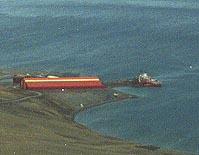|
|
 |
Helicopters on the Healy ... Helo's
by Gerhard Behrens
| If you read the daily log for July 29, 2003, you know that no one actually uses the word: helicopter. Everyone says: hee-low, for the aircraft. And when the helos are scheduled to fly, it is called helo ops, which is a short for helicopter operations. |
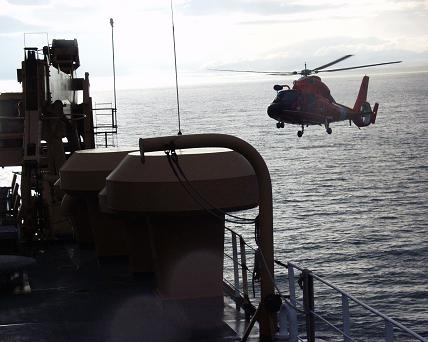
A smooth landing. |
| There are two helos on the ship. Rescue and safety are the main concern. |
| When the helos are getting ready to fly, the back decks of the ship near the landing pad are closed off. If you want to watch from a special spot, you must wear a cranium, which is a special head cover, and you must also wear safety glasses. |
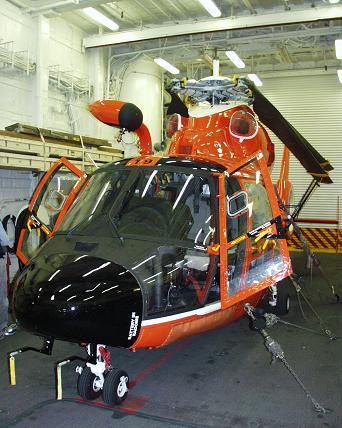
In the hangar. |
The helos are handled with great care. Every day there is a pre-flight check, whether they fly or not. Every week, there is another inspection that checks more items. Every month, there is still another inspection that looks at even more things. On top of that, each helo must have an inspection after 75 hours of flying and another after 125 hours of flying. The mechanics and pilots know every inch of the helo. |
| Lots of questions about the helo can be answered with depends. How far can it travel? Depends. How fast can it go? Depends. Where can you land? Depends. How fast can the ship travel and still land safely? Depends. The answer to these questions depends on conditions such as wind, clouds, the sea, predicted weather, and weight. If the seas are choppy, it might be safer to land if the ship is moving. If the helo is carrying a lot of cargo, it canít travel as far. If itís windy, that will change the gas mileage. If you carry less gas, you can go a bit faster. The pilot has to keep all these things in mind. |
| The pilots look at a gas gauge that tells them how they are flying in pounds of fuel burned per hour. How long the fuel will last is based on how much weight he is carrying, how fast he is going, or how much wind he is fighting. For example the helo computer might read: 600 pounds per hour; if he slows down a bit, heíll be burning 550 pounds per hour; if he goes fast, or takes on a load, it may go to 700 pounds per hour. The helo can carry about 1,800 pounds of fuel, so the pilots are always doing some mental math to figure out how much longer they have to fly. |
| There is a computer on the helo that will fly the craft all by itself so the pilot can look out the window and be another set of eyes when they are trying to find and rescue someone. The pilot must take off and land the helo, but the rest of a flight can be programmed so the helo can fly on its own when necessary. |
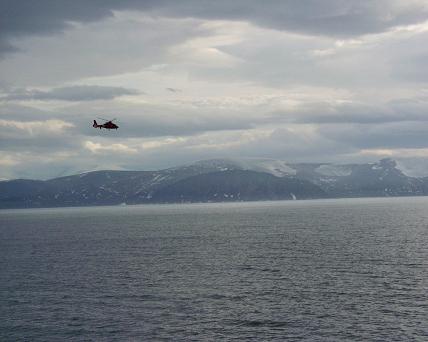
Circling the ship. |
| The Healy is sailing in water that is thousands of miles away from the nearest helicopter garage. So, there are 4 mechanics to help the 4 pilots keep the helos in top shape. They carry a whole supply of spare parts and tools, even one whole spare engine. When they are not being prepared to fly, the helos live in a hanger in the stern of the ship with their propellers folded up. |
| Each pilot has to meet his mins. Mins stands for minimums, which is a set of practice hours. The pilots must meet their mins in flying hours, landing in different ways, flying by instruments, flying while using the safety hoist, and flying with rescue divers. Most pilots have a college degree, then attend the Navy flight school before returning to Coast Guard aviation duty. They are trained to master only this certain kind of Coast Guard helicopter. |
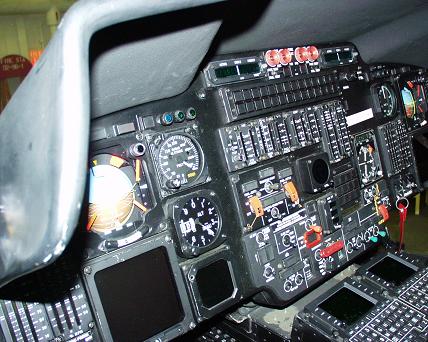
Control panel. |
Like the whole ship, the aviation crew has its own language, too. Here are my two favorite: PaxÖthatís short for passengers or packages, whatever the helo is carrying; Bingo for fuelÖthatís a snappy way of saying the pilot must go for fuel or risk running out of gas. |
|
|


